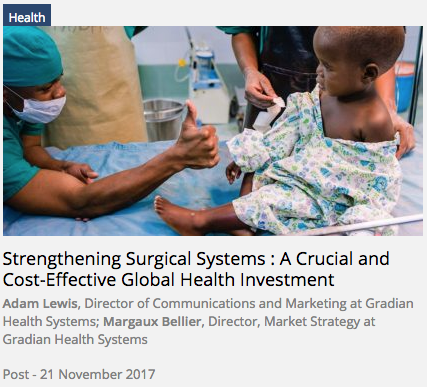
Strengthening Surgical Systems : A Crucial and Cost-Effective Global Health Investment



A handful of cost-effective medical solutions have helped reduce the number of deaths from infectious diseases and childbirth complications. Still, more and more people are dying from surgically-treatable conditions. It is time to shift our focus on strengthening surgical systems. But is it worth the investment? (Short answer: Yes.)
Here’s an excerpt from our latest op-ed – read the rest on “Ideas for Development”: a blog coordinated by the French Development Agency.
Over the past few decades, the world has made unprecedented strides improving health in low- and middle-income countries, where most premature, preventable deaths occur. Since 1990, maternal and child mortality have been cut in half. Deaths from infectious diseases like malaria have followed similar trend lines. Even as HIV/AIDS continues to affect tens of millions of people, death rates have fallen dramatically – one of the most remarkable medical achievements in human history.
Many factors have contributed to this progress, but the world’s preeminent experts on health investments credit a handful of low-cost, easy-to-access solutions for the world’s most vulnerable people, particularly in sub-Saharan Africa and South Asia. We’ve vastly improved our ability to provide affordable interventions like contraception and vaccines, which have helped millions of women avoid life-threatening childbirths and millions of children avoid fatal illnesses like pneumonia and diarrhea. Likewise, one of the ways we’ve reduced malaria mortality is through the distribution of bed nets – another inexpensive intervention – and we’ve greatly expanded access to antiretroviral (ARV) treatment for HIV/AIDS, prolonging lives that would have otherwise been lost to the virus.
Investing in these basic public health products and services is a straightforward calculation : modern contraceptives, vaccines and bed nets cost only a few dollars per unit, and while ARV drugs can cost thousands of dollars a year, commitments from companies and donors have helped bring prices below $100 in many countries. The return on these investments comes in the form of countless lives saved and improved – making them among the most cost-effective in global health.
Rarely mentioned in the conversation about cost-effective health investments is safe surgery – and what it would take to improve access to this vital health service. Surgical conditions comprise a third of the global burden of disease, with nearly 17 million people dying every year from illnesses, injuries and emergencies that could be treated with basic surgical care. These conditions claim more lives than HIV/AIDS, malaria, tuberculosis and childhood illnesses combined, yet most of the world lacks access to surgical treatment. So why is surgery not a priority in global health and for development actors ?